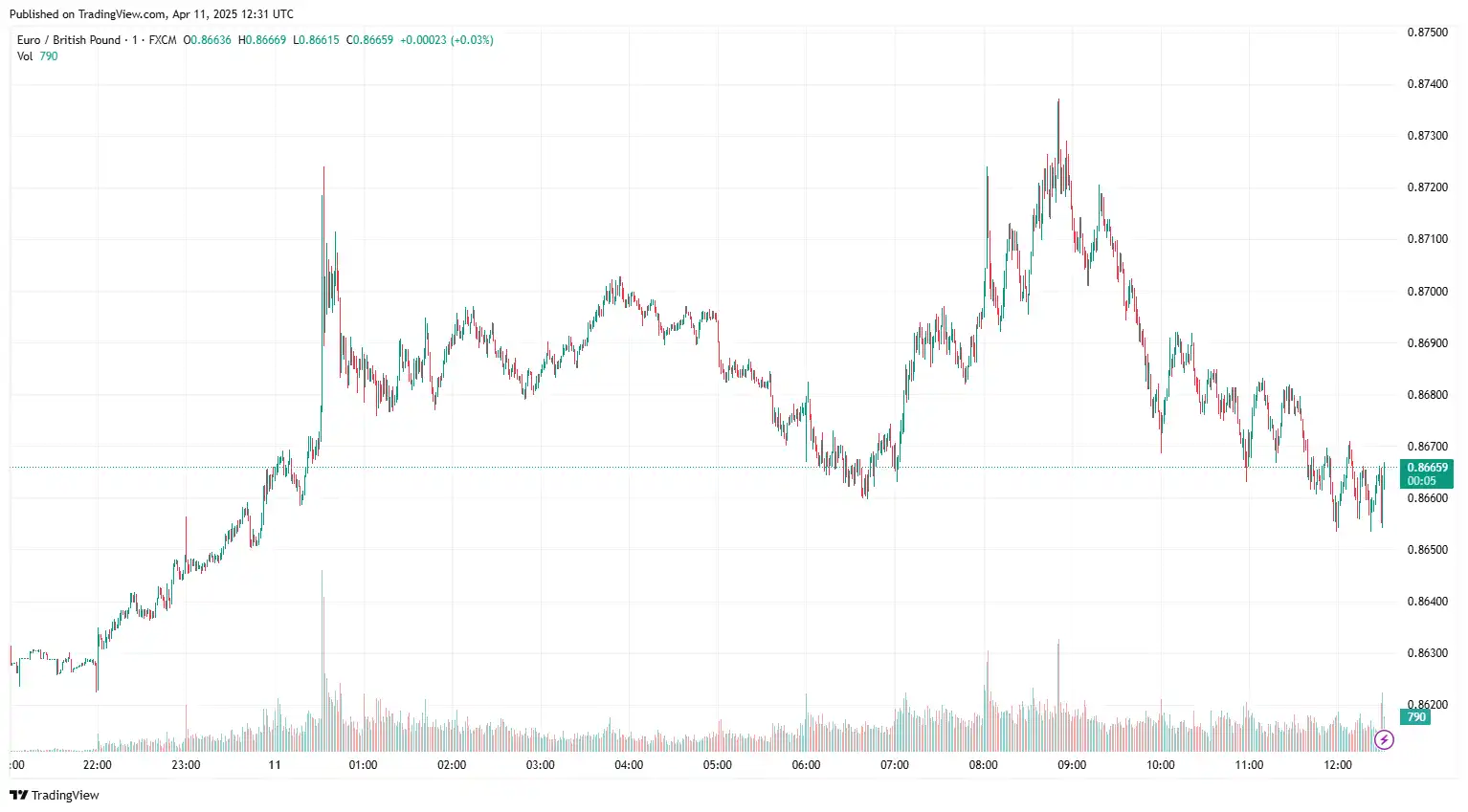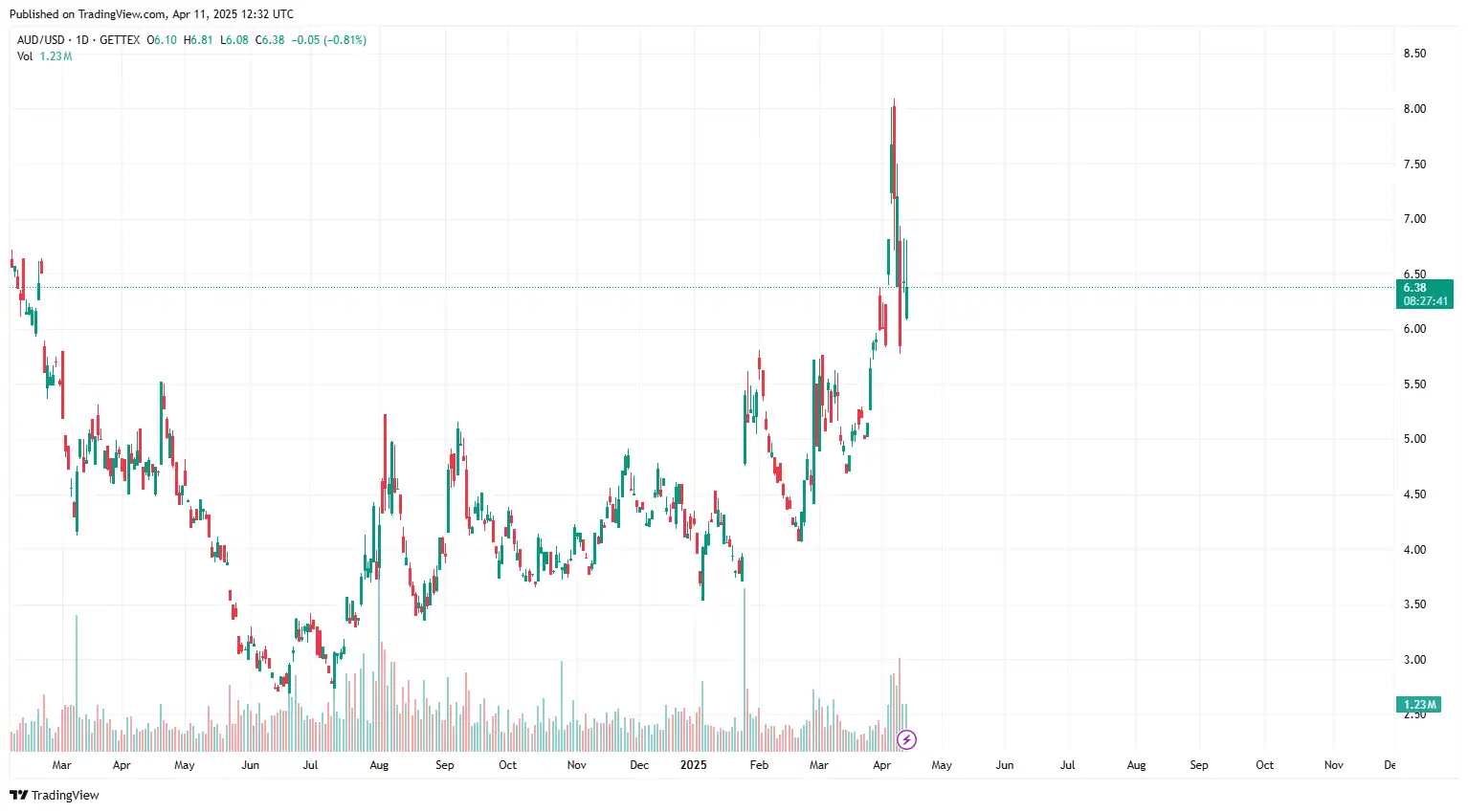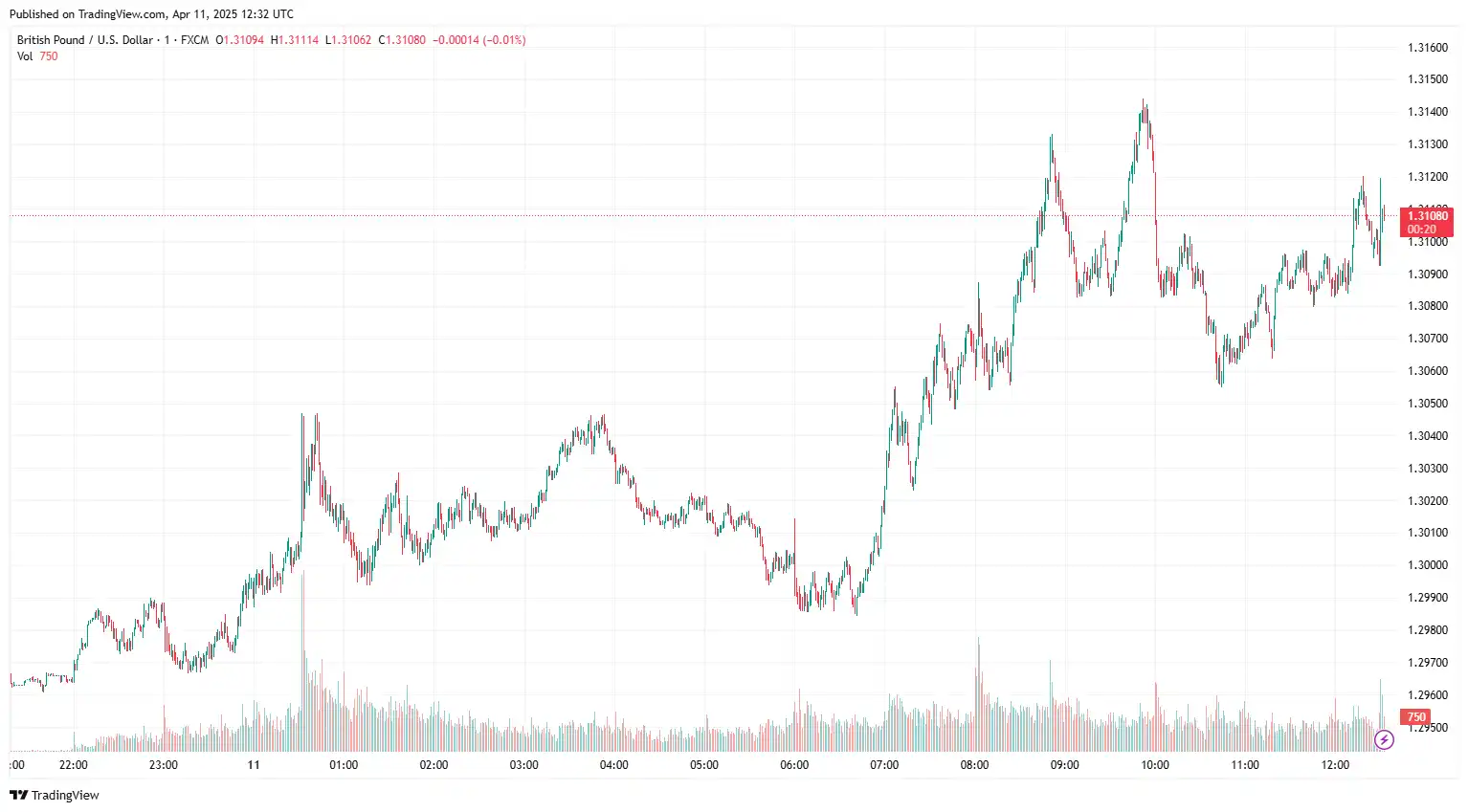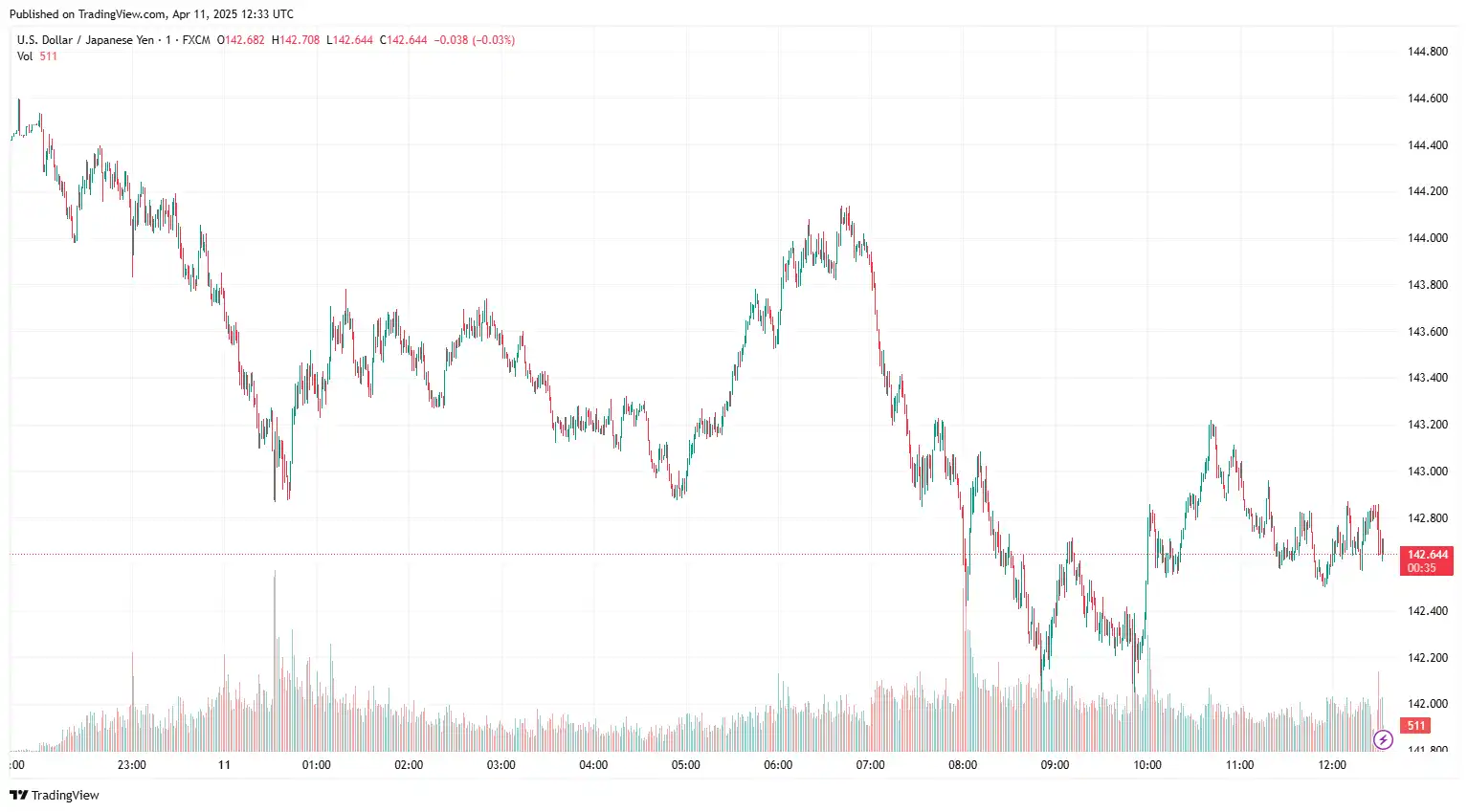EUR/GBP Climbs Amid EU-US Trade Hopes
EUR/GBP edges higher to 0.8727, as the euro gains ground following the European Union (EU) announcement of a 90-day suspension of countermeasures against the United States (US), one day after US President Donald Trump paused previously announced tariffs affecting dozens of countries. On Friday, European Commission President Ursula von der Leyen warned that the European Union (EU) would impose stricter trade measures by imposing higher duties on US digital companies if negotiations with US President Donald Trump fail to end his tariff war against Europe. European Central Bank (ECB) policymaker and Bank of France head François Villeroy de Galhau also cautioned, "Trump's economic and financial agenda is the wrong path," suggesting that the EU shall not follow Trump's financial regulation, hinting at potential financial crises. In March 2025, Germany's Consumer Price Index (CPI) rose by 0.3% compared to February, in line with market forecasts, contributing to an annual inflation rate of 2.2%, a slight decrease from 2.3% in February. In light of the sudden policy reversal by the White House, the EU is now subjected to a 10% duty on exports to the US until July—rather than the 20% "reciprocal tariff," along with Trump's 25% tariffs on steel, aluminium, and cars. While it improved the market mood, it also influenced the European Central Bank (ECB) rate cut expectations.
On the other hand, better-than-anticipated growth outlooks support the pound. The UK economy grew by 0.5% in February, far more than the 0.1% growth predicted by the market and the flat January numbers. In contrast, the Index of Services (February) grew by 0.6% 3M/3M, as opposed to 0.4% in January. Outpacing last month's -0.3% and the projected 0.2%, construction output rose by 0.4% from the previous month. Compared to last month's -0.5% and the forecasted 0.1%, industrial production increased by a remarkable 1.5% month-over-month. Month-over-month, manufacturing production increased by 2.2%, exceeding the prior -1.0% and the predicted 0.2%. The UK's goods trade deficit increased to £20.8 billion in February 2025, surpassing the £18.2 billion the month before and the £17.3 billion anticipated.
BBroader market sentiment around the UK economic data and EU-US trade negotiations will influence the EUR/GBP exchange rate.

AUD/USD Pressured by US-China Trade Concerns
The Australian Dollar lost ground against the greenback, approaching the 0.6216 level, following cautious market sentiment amid deteriorating trade relations between the United States (US) and China and fears of a global economic slowdown. On Thursday, the White House confirmed the imposition of tariffs on Chinese goods, raising the effective rate to 145% while holding a 10% baseline for other countries. On Friday, Chinese President Xi Jinping commented, "There is no winner in a tariff war." In his meeting with Spanish Prime Minister Pedro Sanchez, he also emphasised the trade partnership between China and Europe, aimed at maintaining the international trade order, in which both sides are not just safeguarding their interest but also international fairness and justice. On Wednesday, optimism around resumed trade negotiations between Australia and the European Union (EU) strengthened the Aussie. EU Trade Commissioner Maros Sefcovic proposed establishing a new timeline for conversations with Australian Trade Minister Don Farrell. Ongoing trade tensions between the US and China continue to affect the risk-sensitive Australian dollar after Trump's announcement of an immediate tariff hike on Chinese imports to 125%. This comes in response to China's retaliatory increase to 84% on US goods. In March, China's Consumer Price Index (CPI) declined by 0.1% year-over-year after a 0.7% drop in February, missing the expected 0.1% rise. Monthly CPI inflation decreased by 0.4%, worse than February's 0.2% decline and below market forecasts. Additionally, the Producer Price Index (PPI) fell by 2.5% year-on-year in March, a steeper drop than February's 2.2% decrease and the predicted 2.3% decline.
On the other hand, the US Dollar Index (DXY), a gauge that measures the currency against a basket of six major currencies, fell below 100, reacting to the persistent concerns surrounding global and US economic outlooks. In March, the US Consumer Price Index (CPI) inflation rate fell to 2.4% year-over-year, a decrease from 2.8% in February and below the anticipated 2.6%. The Core CPI, which removes food and energy costs, increased by 2.8% annually, down from 3.1% previously and below the 3.0% prediction. Monthly, the headline CPI declined by 0.1%, while the core CPI rose by 0.1%. Additionally, the latest Federal Open Market Committee (FOMC) meeting minutes revealed policymakers' unanimous approach towards the dual challenge of rising inflation and slowing growth, suggesting a cautious policy stance. On Thursday, Federal Reserve Bank of Boston President Susan Collins pointed out that ongoing uncertainty stemming from the Trump administration's inconsistent tariff policy will continue to weigh on the Fed's ability to adjust policy rates.
Investors will pay close attention to the US March Producer Price Index (PPI) and the preliminary Michigan Consumer Sentiment data, while market sentiment around trade policies will guide the AUD/USD exchange rate.

GBP/USD Gained on Robust UK Growth Outlook
GBP/USD climbed to 1.3063, following robust economic data from the UK. The UK economy expanded by 0.5% in February, well above January's flat figures and the market forecast of 0.1% growth. Meanwhile, the Index of Services (February) increased by 0.6% 3M/3M compared to January's 0.4%. Construction output increased by 0.4% from the previous month, outpacing the estimated 0.2% and last month's -0.3%. Industrial production experienced a substantial rise of 1.5% month-over-month, significantly exceeding the predicted 0.1% and the prior month's -0.5%. Manufacturing output advanced by 2.2% month-over-month, surpassing the anticipated 0.2% and the previous -1.0%. In February 2025, the United Kingdom's goods trade deficit expanded to £20.8 billion, exceeding both the expected £17.3 billion and the previous month's £18.2 billion. While Finance Minister Rachel Reeves called the data "encouraging", it failed to gather the market's attention. Market anticipation that the Bank of England (BoE) will resume its rate-cutting cycle could bolster the sterling. However, concerns stemming from the trade tensions between the US and China could put UK business activity at potential risk.
On Friday, China's Finance Ministry declared that they would introduce additional tariffs on US imports from 84% to 125%, with comments, "If the US continues to impose further tariffs on Chinese goods exported to the US, China will ignore it. If the US insists on continuing to infringe upon China's interests substantively, China will resolutely take countermeasures and fight to the end." In addition, a statement released by China's Commerce Ministry encouraged the US to eliminate the ongoing so-called "reciprocal tariffs" practices and maintain the global trade equilibrium. The statement also noted China's firm opposition towards unilateral tariff measures and retaliation to safeguard its rights and interests. China's retaliatory actions added selling pressures on the USD, removing the gains from the 90-day tariff delay. Moreover, recent CPI data showed that inflationary pressures are reducing more quickly than anticipated, which bolstered predictions that the Fed will continue to lower interest rates. As reported by the US Consumer Price Index (CPI) for March, headline inflation decreased to 2.4% year-over-year, from 2.8% in February and below the 2.6% forecast. The Core CPI increased to 2.8% from 3.1% and missed the 3.0% prediction. The headline CPI fell by 0.1% on a monthly basis, while the core CPI rose by 0.1%.
Apart from the key UK economic data released today, upcoming US key data releases, including the March Producer Price Index (PPI) and preliminary Michigan Consumer Sentiment, will shape the market sentiment around the GBP/USD exchange rate.

USD/JPY Sinks Amid Tariff Worries
USD/JPY wobbled near 142.43 amid the persistent uncertainty surrounding trade policies and concerns over the potential recession, increasing the demand for safe-haven flows and strengthening the yen. On Friday, Japan's Finance Minister Shunichi Kato commented that foreign exchange rates should be set by markets, adding that excess FX volatility negatively impacts the Japanese economy. Stronger-than-anticipated Producer Price Index (PPI) data fuelled hawkish BoJ expectations, underpinning the yen. Japan's Producer Price Index (PPI) rose by 0.4% month-over-month in March 2025, exceeding market expectations of a 0.2% increase. The PPI also grew by 4.2% year-on-year, surpassing the anticipated 3.9% rise. On the global front, US President Donald Trump has agreed to meet with Japanese officials to initiate trade talks following his conversation with Japan's Prime Minister Shigeru Ishiba earlier this week. US Treasury Secretary Scott Bessent later mentioned that Japan might be a key focus in tariff discussions, raising optimism for a potential US-Japan trade agreement and contributing to the strengthening of the JPY.
Conversely, in response to ongoing worries about the US and global economic outlooks, the US Dollar Index (DXY), which compares the dollar to a basket of six major currencies, dropped below 100. The US Consumer Price Index (CPI) inflation rate fell from 2.8% in February to 2.4% in March, less than the 2.6% forecast. The Core CPI, which accounts for expenses for food and energy, grew by 2.8% per year, which was less than the 3.0% forecast and down from 3.1% earlier. The core CPI increased by 0.1% each month, whereas the headline CPI fell by 0.1%. Furthermore, the minutes of the most recent Federal Open Market Committee (FOMC) meeting showed that policymakers unanimously adopted a cautious attitude in response to the challenges of slowing GDP and increasing inflation. Susan Collins, president of the Federal Reserve Bank of Boston, noted Thursday that the Fed's monetary policy outlook will continue to be hampered by the persistent uncertainty that emerged from the Trump administration's unpredictable tariff policy.
Today’s US Producer Price Index (PPI) for March, the advanced Michigan Consumer Sentiment report, speeches by Federal Reserve (Fed) Bank of St. Louis President Alberto Musalem and Fed Bank of New York President John Williams, and any major shift in the market sentiment will drive the USD/JPY exchange rate.

Stay Ahead in the Currency Game
Whether you're a daily FX trader or handle international transactions regularly, our 'Currency Pulse' newsletter delivers the news you need to make more informed decisions. Receive concise updates and in-depth insights directly in your LinkedIn feed.
Subscribe to 'Currency Pulse' now and never miss a beat in the currency markets!
Ready to act on today’s insights? Get a free quote or give us a call on: +44 (0)20 7740 0000 to connect with a dedicated portfolio manager for tailored support.
Important: This blog is for informational purposes only and should not be considered financial advice. Currency Solutions does not consider individual investment goals, financial circumstances, or specific requirements of readers. We do not endorse or recommend any particular financial strategies or products discussed. Currency Solutions provides this content as is, without any guarantees of completeness, accuracy, or timeliness.



